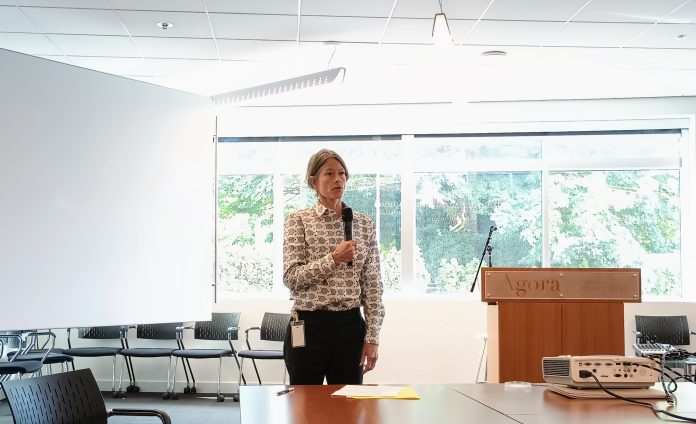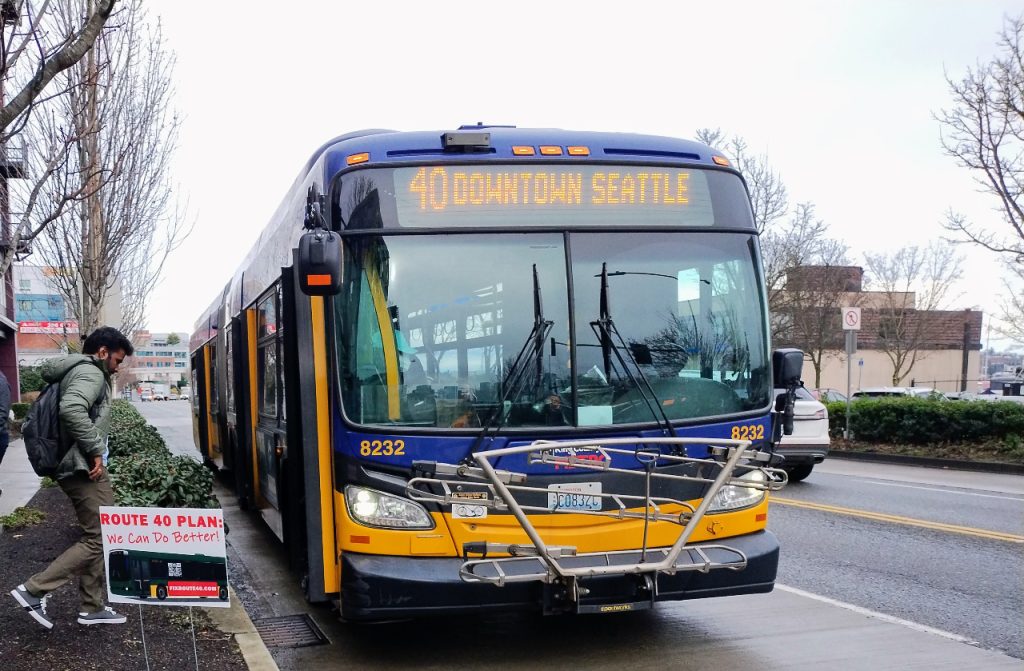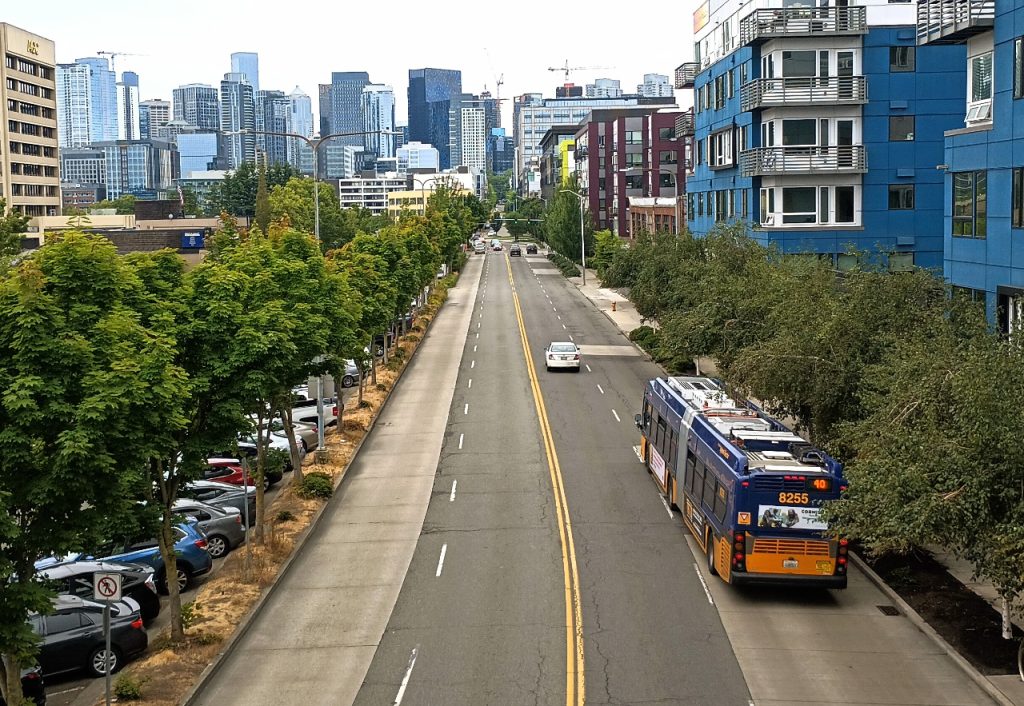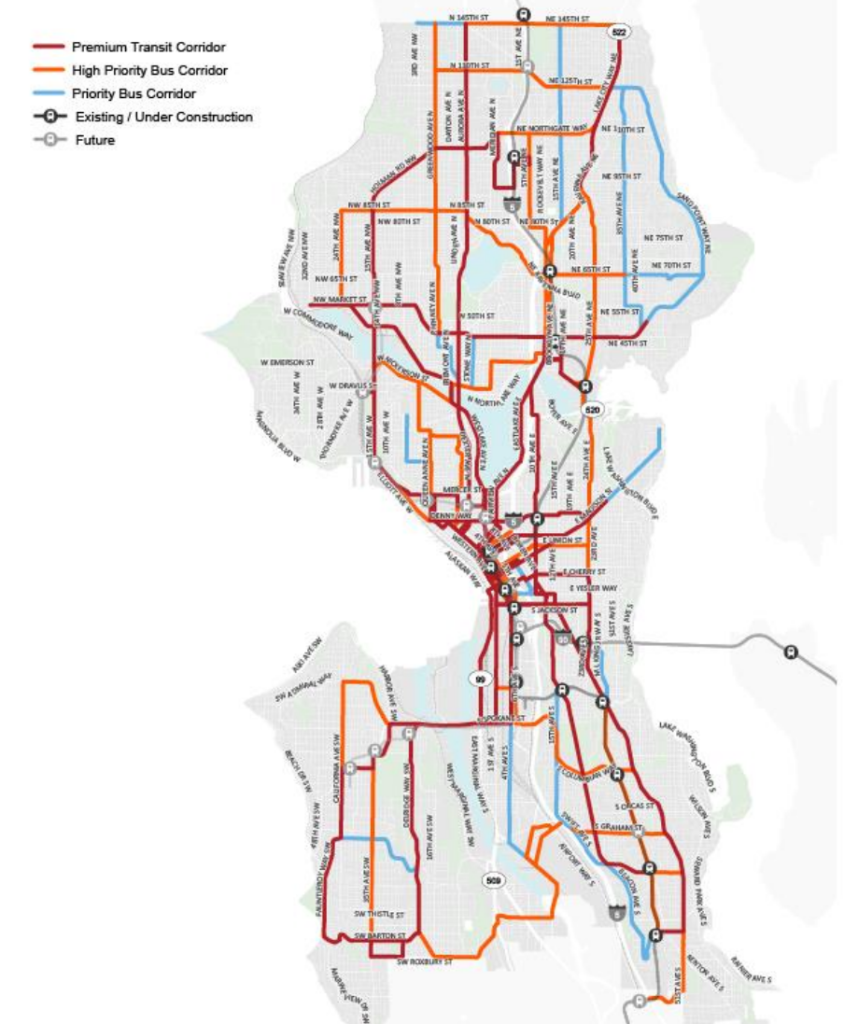
Since 2021, business groups in North Seattle have been pushing to get the Seattle Department of Transportation (SDOT) to reconsider transit upgrades to the Route 40, which connects South Lake Union, Fremont, Ballard, Crown Hill, and Northgate. The project includes street improvements intended to increase safety, along with dedicated bus lanes through some of the route’s most notorious pinch points. Though the plans have gone through several iterations in response to community feedback, the core transit improvements have not been watered down, and the project started construction earlier this year.
Nonetheless, a budget amendment introduced by Seattle City Council President Sara Nelson and approved last week seems intended to give transit upgrades like those for the Route 40 additional scrutiny.
Nelson’s statement of legislative intent (SLI) asks SDOT to produce a report detailing the performance measures and evaluation criteria used when deciding to add bus-only lanes to “corridor projects outside of Regional Centers,” specifically citing projects like the Route 40 and the RapidRide R, which is still in planning and not set to come online until 2031. The 2015 Move Seattle Levy pledged RapidRide level upgrades to seven corridors including Route 40, but Mayor Jenny Durkan downgraded plans in 2018, along with Route 44 and 48.

“The report should detail the specific evaluation criteria used, such as: existing transit ridership and projected transit ridership after the bus lanes are installed, expected travel time savings (using nonaggregated, local data), improved transit speed and reliability, impact on general traffic capacity and congestion (using local data), and freight access and mobility considerations,” Nelson’s SLI text reads. “The report should describe the environmental and economic impacts considered, such as impacts to adjoining small businesses, net impact to carbon emissions including potential vehicle idling time, and neighborhood construction impacts.”
The business groups pushing to scale back the proposed transit improvements for the Route 40, which include the Ballard Alliance, the Fremont Chamber of Commerce, and the North Seattle Industrial Association, have also raised the specious argument that bus-only lanes increase carbon emissions. They argue that even though more than 8,000 people ride the Route 40 every weekday, speed and reliability improvements need a second look because ridership is lower than it was before the pandemic.
“One lane of car traffic headed north is very likely to cause long backups in the summer as the Fremont Bridge is raised. The summer cueing [sic] currently extends about a half mile down Westlake with two lanes for car traffic,” a letter signed by the coalition sent this past January read. “Again, with ridership still at ~ 50% of pre-COVID numbers and a lack of data on post-COVID ridership trends, this change would have significant impact on workers, residents and small businesses who must have dependable access over the Fremont Bridge.”
Even after the pandemic-era ridership drop affecting most (but not all) King County Metro routes, the 40 is the busiest bus route in North Seattle that isn’t yet a RapidRide line, and it’s trending upward. As of April 2024, Route 40 ridership was at 64% of its three-year pre-pandemic baseline. Running through the heart of Amazon’s campus, the route appears highly sensitive to return-to-office rates at tech giants with offices in South Lake Union.

At a budget meeting Friday, Nelson noted the concerns raised by the business coalition, which has been asking SDOT for granular traffic modeling data seemingly in the hopes of trying to pick it apart. In her comments, she seemed to suggest that if she had wanted to stop the Route 40 upgrades from happening, she could have already done it.
“Let’s be real — if a councilmember wants to kill a project, you can kill a project, by going into a [Capitol Improvement Program], or by doing something in one’s capacity as a chairperson,” Nelson said. “I am simply trying to respond to a request for data that is up-to-date, and there is some concern that perhaps the data that SDOT is using to plan not just this line but potentially future bus-only lanes, it could be out-of-date and perhaps not based on local data.”
In 2023, The Urbanist reported on an email sent by Eugene Wasserman, the president of the North Seattle Industrial Association, to D6 Councilmember Dan Strauss in which he asserted that Nelson would be opposing the Route 40 upgrades, in an apparent bid to get Strauss to do the same. A longtime ally of Nelson’s, Wasserman donated to her failed 2017 council campaign and her successful one in 2021.
So far Strauss has remained broadly supportive of the Route 40 upgrades, but at last week’s meeting he hedged.
“I support transit-only lanes 100%,” Strauss said, while immediately noting a limitation on his support for transit-only lanes. “The worry about peak hour versus non-peak hour […] along Westlake, under the Ballard Bridge at that pinch point, and along Market Street and Leary, those are the three specific pinch points. Because we see that during non-peak hours, there’s a lot of room on the roadway. During peak hours it’s absolutely necessary for those bus lanes to be bus-only.”
In the end, the amendment was fairly uncontroversial and passed unanimously. Nelson will get her additional report intended to provide fodder for the anti-bus-lane business coalition.
However, unwinding the transit upgrades could be a harder lift. The City has rated Westlake Avenue and Leary Way bus lanes as high priorities very recently in the Seattle Transportation Plan (STP), which Nelson and her colleagues approved earlier this year in another unanimous vote. The STP details quite specifically the criteria that SDOT uses to decide where to add bus only lanes. In a map included in the plan breaking down different types of transit streets, Westlake Avenue and Leary Way are both designated as “premium transit corridors,” a label that is intended to convey the “highest-level arterial transit need” of anywhere in the city.

That said, it’s always been clear that the high-level Seattle Transportation Plan would struggle to be a substitute for local fights over allocating street space on each discreet project — no matter how much legwork the plan did to try to address some of those potential conflicts ahead of time.
Innocuous on its surface, the future report appears intended to provide ammunition for future fights over creating dedicated space for buses, risking a precedent of second- and third-guessing once the project decision has been made. Route 40 bus lanes are not set to be fully open until 2026 — seven years after initial planning efforts were launched. So, the last ditch effort may have enough time to find a pretext and a political opening to scuttle the Route 40 lanes. But more broadly, it opens the door to routes across the city potentially having their existing bus lanes removed if ridership dips, creating a negative feedback loop.
Removing transit priority would come with significant costs, weakening Seattle’s credibility on climate. Adding even more red tape to the process of speeding up buses and making them more enticing to riders seems to be contrary to City goals around increasing transit ridership and reducing emissions.
But at least Seattleites can be thankful that Sara Nelson doesn’t want to kill their transit upgrade projects outright. At least not right now.
Ryan Packer has been writing for The Urbanist since 2015, and currently reports full-time as Contributing Editor. Their beats are transportation, land use, public space, traffic safety, and obscure community meetings. Packer has also reported for other regional outlets including BikePortland, Seattle Met, and PubliCola. They live in the Capitol Hill neighborhood of Seattle.

